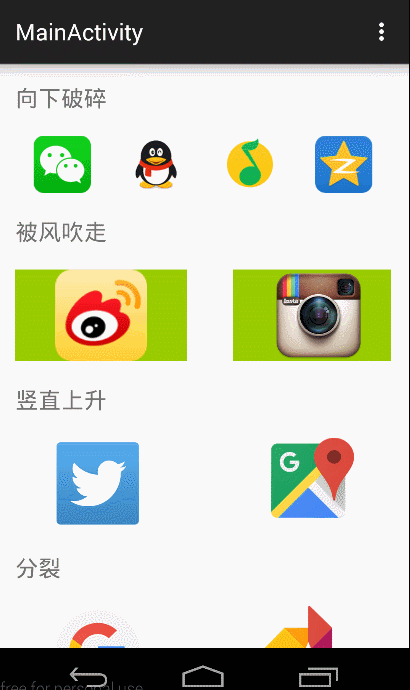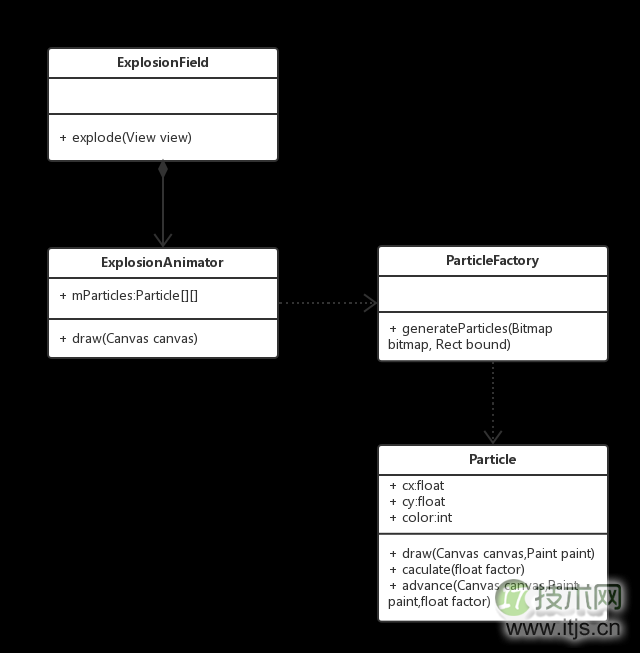简介
最近在闲逛的时候,发现了一款粒子爆炸特效的控件,觉得比较有意思,效果也不错。
但是代码不好扩展,也就是说假如要提供不同的爆炸效果,需要修改的地方比较多。于是我对源代码进行了一些重构,将爆炸流程和粒子运动分离。
对于源码,大家可以参考以下链接
链接1? ??链接2
上面两套代码,其实结构都是一样的,但是实现的效果不同(其实就是粒子运动的算法不同)。
该文文章,将给大家介绍粒子爆炸特效的实现方式,替大家理清实现思路。
实现效果如下:

类设计
类设计图如下:

ExplosionField,爆炸效果发生的场地,是一个view。当一个控件需要爆炸时,需要为控件生成一个ExplosionField,这个ExplosionField**覆盖整个屏幕**,于是我们才能看到完整的爆炸效果。
ExplosionAnimator,爆炸动画,其实是一个计时器,继承自ValueAnimator。1024s内,完成爆炸动画,每次计时,就更新所有粒子的运动状态。draw()方法是它最重要的方法,也就是使所有粒子重绘自身,从而实现动画效果。
ParticleFactory,是一个抽象类。用于产生粒子数组,不同的ParticleFactory可以产生不同类型的粒子数组。
Particle,抽象的粒子类。代表粒子本身,必须拥有的属性包括,当前自己的cx,cy坐标和颜色color。必须实现两个方法,d**raw()方法选择怎么绘制自身(圆形还是方形等),**caculate()计算当前时间,自己所处的位置。
控件的使用
控件使用很简单,首先要实现不同的爆炸效果,需要给ExplosionField传入不同的ParticleFactory工厂,产生不同的粒子。
ExplosionField explosionField = new ExplosionField(this,new FallingParticleFactory());
然后哪个控件需要爆炸效果,就这样添加
explosionField.addListener(findViewById(R.id.text)); explosionField.addListener(findViewById(R.id.layout1));
这样就为两个控件添加了爆炸效果,注意layout1代表的是一个viewgroup,那么我们就会为viewgroup中的每个view添加爆炸效果。
我们可以想象,在ExplosionField的构造函数中,传入不同的ParticleFactory,就可以生成不同的爆炸效果。
爆炸实现思路
1、获取当前控件背景bitmap
例如,例子中使用的是imageview,对于这个控件,我提供了一个工具类,可以获得其背景的Bitmap对象
public static Bitmap createBitmapFromView(View view) {
view.clearFocus();
Bitmap bitmap = createBitmapSafely(view.getWidth(), view.getHeight(), Bitmap.Config.ARGB_8888, 1);
if (bitmap != null) {
synchronized (sCanvas) {
Canvas canvas = sCanvas;
canvas.setBitmap(bitmap);
view.draw(canvas);
canvas.setBitmap(null);
}
}
return bitmap;
}
public static Bitmap createBitmapSafely(int width, int height, Bitmap.Config config, int retryCount) {
try {
return Bitmap.createBitmap(width, height, config);
} catch (OutOfMemoryError e) {
e.printStackTrace();
if (retryCount > 0) {
System.gc();
return createBitmapSafely(width, height, config, retryCount - 1);
}
return null;
}
}
上面的方法,简而言之,就是将控件的Bitmap对象复制了一份,然后返回。
我们知道,bitmap可以看成是一个像素矩阵,矩阵上面的点,就是一个个带有颜色的像素,于是我们可以获取每个点(未必需要每个)的颜色和位置,组装成一个对象Particle,这么一来,Particle就代表带有颜色的点了。
2、将背景bitmap转换成Particle数组
获取Bitmap以后,我们交给ParticleFactory进行加工,根据Bitmap生产Particle数组。
public abstract class ParticleFactory {
public abstract Particle[][] generateParticles(Bitmap bitmap, Rect bound);
}
例如我们来看一个简单实现类,也是gif图中,第一个下落效果的工厂类
public class FallingParticleFactory extends ParticleFactory{
public static final int PART_WH = 8; //默认小球宽高
public Particle[][] generateParticles(Bitmap bitmap, Rect bound) {
int w = bound.width();//场景宽度
int h = bound.height();//场景高度
int partW_Count = w / PART_WH; //横向个数
int partH_Count = h / PART_WH; //竖向个数
int bitmap_part_w = bitmap.getWidth() / partW_Count;
int bitmap_part_h = bitmap.getHeight() / partH_Count;
Particle[][] particles = new Particle[partH_Count][partW_Count];
Point point = null;
for (int row = 0; row < partH_Count; row ++) { //行
for (int column = 0; column < partW_Count; column ++) { //列
//取得当前粒子所在位置的颜色
int color = bitmap.getPixel(column * bitmap_part_w, row * bitmap_part_h);
float x = bound.left + FallingParticleFactory.PART_WH * column;
float y = bound.top + FallingParticleFactory.PART_WH * row;
particles[row][column] = new FallingParticle(color,x,y,bound);
}
}
return particles;
}
}
其中Rect类型的bound,是代表原来View控件的宽高信息。
根据我们设定的每个粒子的大小,和控件的宽高,我们就可以计算出,有多少个粒子组成这个控件的背景。
我们取得每个粒子所在位置的颜色,位置,用于生产粒子,这就是FallingParticle。
3、生成爆炸场地,开始爆炸动画流程
爆炸时需要场地的,也就是绘制粒子的地方,我们通过给当前屏幕,添加一个覆盖全屏幕的ExplosionField来作为爆炸场地。
public class ExplosionField extends View{
...
/**
* 给Activity加上全屏覆盖的ExplosionField
*/
private void attach2Activity(Activity activity) {
ViewGroup rootView = (ViewGroup) activity.findViewById(Window.ID_ANDROID_CONTENT);
ViewGroup.LayoutParams lp = new ViewGroup.LayoutParams(
ViewGroup.LayoutParams.MATCH_PARENT, ViewGroup.LayoutParams.MATCH_PARENT);
rootView.addView(this, lp);
}
...
}
爆炸场地添加以后,我们响应控件的点击事件,开始动画
首先是震动动画
/**
* 爆破
* @param view 使得该view爆破
*/
public void explode(final View view) {
//防止重复点击
if(explosionAnimatorsMap.get(view)!=null&&explosionAnimatorsMap.get(view).isStarted()){
return;
}
if(view.getVisibility()!=View.VISIBLE||view.getAlpha()==0){
return;
}
//为了正确绘制粒子
final Rect rect = new Rect();
view.getGlobalVisibleRect(rect); //得到view相对于整个屏幕的坐标
int contentTop = ((ViewGroup)getParent()).getTop();
Rect frame = new Rect();
((Activity) getContext()).getWindow().getDecorView().getWindowVisibleDisplayFrame(frame);
int statusBarHeight = frame.top;
rect.offset(0, -contentTop - statusBarHeight);//去掉状态栏高度和标题栏高度
//震动动画
ValueAnimator animator = ValueAnimator.ofFloat(0f, 1f).setDuration(150);
animator.addUpdateListener(new ValueAnimator.AnimatorUpdateListener() {
Random random = new Random();
@Override
public void onAnimationUpdate(ValueAnimator animation) {
view.setTranslationX((random.nextFloat() - 0.5f) * view.getWidth() * 0.05f);
view.setTranslationY((random.nextFloat() - 0.5f) * view.getHeight() * 0.05f);
}
});
animator.addListener(new AnimatorListenerAdapter() {
@Override
public void onAnimationEnd(Animator animation) {
super.onAnimationEnd(animation);
explode(view, rect);//爆炸动画
}
});
animator.start();
}
震动动画很简单,就是x,y方向上,随机产生一些位移,使原控件发生移动即可。
在震动动画的最后,调用了爆炸动画,于是爆炸动画开始。
private void explode(final View view,Rect rect) {
final ExplosionAnimator animator = new ExplosionAnimator(this, Utils.createBitmapFromView(view), rect,mParticleFactory);
explosionAnimators.add(animator);
explosionAnimatorsMap.put(view, animator);
animator.addListener(new AnimatorListenerAdapter() {
@Override
public void onAnimationStart(Animator animation) {
//缩小,透明动画
view.animate().setDuration(150).scaleX(0f).scaleY(0f).alpha(0f).start();
}
@Override
public void onAnimationEnd(Animator animation) {
view.animate().alpha(1f).scaleX(1f).scaleY(1f).setDuration(150).start();
//动画结束时从动画集中移除
explosionAnimators.remove(animation);
explosionAnimatorsMap.remove(view);
animation = null;
}
});
animator.start();
}
爆炸动画首先将原控件隐藏。
我们来看爆炸动画的具体实现
public class ExplosionAnimator extends ValueAnimator {
...
public ExplosionAnimator(View view, Bitmap bitmap, Rect bound,ParticleFactory particleFactory) {
mParticleFactory = particleFactory;
mPaint = new Paint();
mContainer = view;
setFloatValues(0.0f, 1.0f);
setDuration(DEFAULT_DURATION);
mParticles = mParticleFactory.generateParticles(bitmap, bound);
}
//最重要的方法
public void draw(Canvas canvas) {
if(!isStarted()) { //动画结束时停止
return;
}
//所有粒子运动
for (Particle[] particle : mParticles) {
for (Particle p : particle) {
p.advance(canvas,mPaint,(Float) getAnimatedValue());
}
}
mContainer.invalidate();
}
@Override
public void start() {
super.start();
mContainer.invalidate();
}
}
实现很简单,就是根据工厂类,生成粒子数组。
而其实质是一个ValueAnimator,在一定时间内,从0数到1。
然后提供了一个draw()方法,方法里面调用了每个粒子的advance()方法,并且传入了当前数到的数字(是一个小数)。
advance()方法里,其实调用了draw()方法和caculate()方法。
上面的实现,其实是一个固定的流程,添加了爆炸场地以后,我们就开始从0数到1,在这个过程中,粒子会根据当前时间,绘制自己的位置,所以粒子的位置,其实是它自己决定的,和流程无关。
也就是说,我们只要用不同的算法,绘制粒子的位置即可,实现了流程和粒子运动的分离。
4、怎么运动?粒子自己最清楚
举个例子,gif图中,下落效果的粒子是这样运动的
public class FallingParticle extends Particle{
static Random random = new Random();
float radius = FallingParticleFactory.PART_WH;
float alpha = 1.0f;
Rect mBound;
/**
* @param color 颜色
* @param x
* @param y
*/
public FallingParticle(int color, float x, float y,Rect bound) {
super(color, x, y);
mBound = bound;
}
...
protected void caculate(float factor){
cx = cx + factor * random.nextInt(mBound.width()) * (random.nextFloat() - 0.5f);
cy = cy + factor * random.nextInt(mBound.height() / 2);
radius = radius - factor * random.nextInt(2);
alpha = (1f - factor) * (1 + random.nextFloat());
}
}
caculate(float factor)方法,根据当前时间,计算粒子的下一个位置
我们可以看到,在这个粒子中,cy也就是竖直方向上是不断增加的,cx也就是水平方向上,是随机增加或者减少,这样就形成了下落效果。
计算出当前位置以后,粒子就将自己绘制出来
protected void draw(Canvas canvas,Paint paint){
paint.setColor(color);
paint.setAlpha((int) (Color.alpha(color) * alpha)); //这样透明颜色就不是黑色了
canvas.drawCircle(cx, cy, radius, paint);
}
怎么扩展?
从上面的代码结构可以看出,爆炸流程和粒子具体运动无关,最重要的是,大家要实现自己的caculate()方法,决定粒子的运动形态。
而不同的粒子可以由对应的工厂产生,所以要扩展爆炸特性,只需要定义一个粒子类,和生成粒子类的工厂即可。
源码下载? ??github地址


